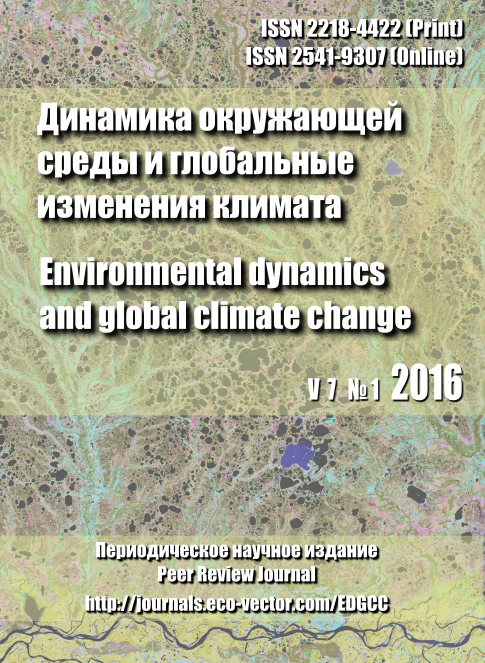Late holocene climate and vegetation changes around lake Malye Chany
- Authors: Zhilich SV1,2, Rudaya NA1,3, Krivonogov SK2,3
-
Affiliations:
- Институт археологии и этнографии СО РАН
- Институт геологии и минералогии СО РАН
- Новосибирский национальный исследовательский государственный университет
- Issue: Vol 7, No 1 (2016)
- Pages: 68-75
- Section: Articles
- Published: 15.06.2016
- URL: https://edgccjournal.org/EDGCC/article/view/6338
- DOI: https://doi.org/10.17816/edgcc7168-75
- ID: 6338
Cite item
Full Text
Abstract
The paper presents the palynological and sedimentological study of bottom sediments of Lake Malye Chany. Lake Malye Chany is one of the five basins of the largest lake in Western Siberia - Lake Chany. Lake Malye Chany is situated in the forest-steppe zone in southern part of the West Siberia. Two rivers, Chulym and Kargat, flow into the lake. The climate of the area is continental. We used palynological method to reconstruct the late Holocene climate and vegetation around the lake and sedimentological method to reconstruct the history of the lake development. According to the sedimentological data we recognized two distinct stages in lacustrine conditions. At the earliest stage terrigenous material dominated in the sediments, river’s delta penetrated into the center of the lake which implies that lake was very shallow; about 4 ka BP climate around the lake was very dry, sage steppe dominated. Pollen samples from this stage contained large amount of chlamydospores of Glomus and charcoal particles. These non-pollen palynomorphs are indicators of dry climate and high intensively of soil erosion processes. At the second stage after 3 ka BP sediments predominately consisted of organic matter and autogenic minerals, the lake became gradually deeper. According to pollen data the period between 3-2 ka BP was wetter and a bit colder than the previous one; local plant associations were dominated by sedge-grass steppe. After 2 ka BP climate became wetter and colder which resulted in a highest stand of the lake. Pollen samples from that stage showed high concentrations of green algae (Pediastrum boryanum, Botryococcus braunii, Tetraedron minimum). These non-pollen palynomorphs are associated with open water estuaries with oligo- to mesotrophyc conditions. From 2 ka BP onward concentrations of Anabaena akinets increases dramatically. Blue-green alga Anabaena is an indicator of phosphoric eutrophication possibly related to human activity (farming, cattle breading) in the lake region. During the period 2-0 ka BP forest-steppe dominates and lake banks have been gradually covered by macrophyts (pondgrass, typha, reed).
Keywords
About the authors
S V Zhilich
Институт археологии и этнографии СО РАН; Институт геологии и минералогии СО РАН
Author for correspondence.
Email: snezhy@yandex.ru
N A Rudaya
Институт археологии и этнографии СО РАН; Новосибирский национальный исследовательский государственный университет
Email: snezhy@yandex.ru
S K Krivonogov
Институт геологии и минералогии СО РАН; Новосибирский национальный исследовательский государственный университет
Email: snezhy@yandex.ru
References
- Ермолаев В., Визер Л. 2010. Современное экологическое состояние озера Чаны (Западная Сибирь) // География и природные ресурсы. Т. 2. С. 40-46.
- Жилич С.В., Рудая Н.А., Назарова Л.Б., Палагушкина О.В., Кривоногов С.К. 2015. Изменения озера Чаны и окружающих ландшафтов во второй половине голоцена // Проблемы археологии, этнографии, антропологии Сибири и сопредельных территорий. Т. ХХI. C. 232-236.
- Королюк А. Ю., Киприянова Л. М. 2005. Растительные сообщества Центральной Барабы (район озера Чаны) // Сибирский экологический журнал. Т. 12 (2). С. 193-200.
- Хазин Л.Б. 2013. Голоценовые остракоды юга Западно-Сибирской равнины и Северного Казахстана: эколого-таксономические ассоциации, климатостратиграфическая корреляция и палеогеографические связи: автореферат дис.. канд. геол.-мин. наук. Новосибирск.
- Bakker M., Van Smeerdijk D. G. 1982. A palaeoecological study of a late Holocene section from “Het Ilperveld”, Western Netherlands //Review of palaeobotany and palynology. V. 36 (1). P. 95-163.
- Blaauw M., Christen J.A. 2011. Flexible paleoclimate age - depth models using an autoregressive gamma process // Bayesian Analysis. V. 3 (6). P. 457-474.
- Cook, E.J., van Geel, B., van der Kaars, S., van Arkel, J.2011. A review of the use of non-pollen palynomorphs in palaeoecology withexamples from Australia // Palynology. V. 35 (2). P. 155-178.
- Dynamics. V. 12. P. 185-194.
- Faegri K., Iversen J. 1989. Textbook of Pollen Analysis. Chichester: John Wiley & Sons. 328 p.
- Grimm E. 2004. Tilia software 2.0.2. Illinois State Museum Research and Collection Center Springfield.
- Kendall M.G., Stuart A. 1962. The advanced theory of statistics. V. 1: Distribution theory. London: Charles Griffin & Co, Ltd.
- Kremenetski C.V., Tarasov, P.E., Cherkinsky A.E. 1997. The Latest Pleistocene in Southwestern Siberia and Kazakhstan // Quaternary International. V. 41-42. P. 125-134.
- Krivonogov S.K., Takahara H., Yamamuro M., Preis Yu.I., Khazina I.V., Khazin L.B., Safonova I.Y., Ignatova N.V. 2012. Regional to local environmental changes in southern Western Siberia: evidence from biotic records of Mid to Late Holocene sediments of Lake Beloye // Palaeogeography, Palaeoclimatology, Palaeoecology. V. 331-332. P. 177-193.
- Prentice C.I., Guiot J., Huntley B., Jolly D., Cheddadi R. 1996. Reconstructing biomes from palaeoecological data: a general method and its application to European pollen data at 0 and 6 ka // Climate. V. 12. №. 3. P. 185-194
- Rudaya N., Nazarova L., Nourgaliev D., Palagushkina O., Papin D., Frolova L. 2012. Mid-late Holocene environmental history of Kulunda, southern West Siberia: vegetation, climate and humans // Quaternary Science Reviews. V. 48. P. 32-42.
- Van Geel B. 2001. Non-pollen palynomorphs. V. 3. Tracking environmental change using lake sediments: Terrestrial, algal and siliceous indicators. Dordrecht: Kluwer Academic Publishers.
- Van Geel B., Mur L. R., Ralska-Jasiewiczowa M., Goslar T. 1994. Fossil akinetes of Aphanizomenon and Anabaena as indicators for medieval phosphate-eutrophication of Lake Gosciaz (Central Poland) // Review of palaeobotany and Palynology. V. 83(1). P. 97-105.
Supplementary files










